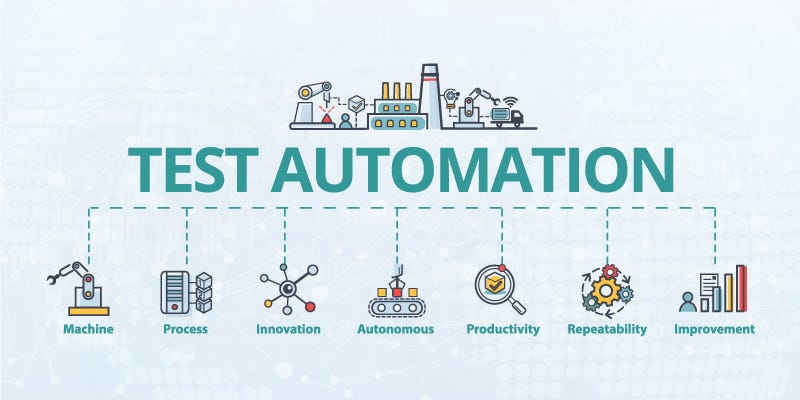Automation Testing Frameworks: Simplifying Complex Testing Scenarios
Automation Testing Frameworks: Simplifying Complex Testing Scenarios
Blog Article
From Handbook to Automated Testing: A Comprehensive Guide to Transitioning Efficiently and Efficiently
In the world of software program testing, the shift from handbook to automated procedures has actually come to be a significantly crucial shift for organizations seeking to improve performance and accuracy in their testing techniques. As technology continues to advance, the need for seamless and reliable automated testing techniques has actually never been extra pressing. The trip from manual to automated testing is not without its obstacles, but when approached strategically and with a clear strategy in mind, the advantages can be substantial - automation testing. In this thorough guide, we will certainly explore vital steps and factors to consider necessary for an effective shift, from the first choice of devices to the assimilation of automation into existing process. Stay tuned to discover the understandings that will assist lead the way for a smoother and a lot more effective screening procedure.
Benefits of Automated Checking
Automated screening offers various advantages, boosting performance and precision in software program growth processes. Automated examinations can be run concurrently on several gadgets and operating systems, dramatically speeding up the screening phase compared to hand-operated testing.
In addition, automated testing ensures a greater level of precision in finding problems. Consistency in screening is also boosted, as automated examinations perform the very same actions precisely each time they are run.
Picking the Right Devices

To start with, evaluate your goals and needs. Understand the range of your task, the modern technologies included, and the capability of your team. This analysis will assist you establish the attributes and capabilities you require in your screening devices.
Second of all, consider the compatibility of the devices with your existing procedures and systems. Smooth assimilation with your existing software program growth lifecycle is essential to ensure a smooth transition to automation.
Additionally, assess the scalability and flexibility of the devices. As your screening needs develop, the tools should have the ability to adjust and fit changes properly.
Last but not least, variable in the assistance and community around the devices. Durable support and an active customer area can supply important resources and aid when applying automated testing. By thoroughly thinking about these aspects, you can choose the right tools that line up with your requirements and established the stage for an effective transition to automated screening.
Writing Efficient Test Scripts

When crafting examination scripts, it is important to take into consideration the certain needs of the software program being tested and guarantee that the scripts attend to all vital capabilities. Descriptive and clear naming conventions for examination scripts and examination cases can boost readability and maintainability. Additionally, integrating error handling systems within the examination scripts can assist in recognizing and addressing problems promptly.
Additionally, arranging test scripts right into modular components can boost reusability and scalability, reducing redundancy and boosting efficiency in examination manuscript maintenance. Routine testimonials and updates to evaluate manuscripts are important to maintain pace with progressing software program requirements and performances. By adhering to these principles, testers can produce durable and reliable examination manuscripts that contribute significantly to the success of automated testing procedures.
Integrating Automation Into Workflows
By seamlessly incorporating automated view website testing tools like Selenium or Appium into the software application development lifecycle, groups can attain faster responses on code changes, leading to quicker insect detection and resolution. This combination enables for continuous screening throughout the advancement process, ensuring that any kind of concerns are recognized early on, resulting in higher software program top quality. Appropriate integration of automation devices requires cooperation in between advancement, screening, and procedures groups to develop a unified process that enhances efficiency and performance in providing top notch software application items.
Making Sure a Smooth Shift
Successfully transitioning to automated screening entails careful preparation and careful implementation to decrease interruptions and take full advantage of efficiency in the software program development procedure - automation testing. To guarantee a smooth transition, it is necessary to find out start by carrying out an extensive analysis of the current screening processes and determining locations where automation can bring the most considerable benefits. Engaging with all stakeholders at an early stage at the same time, consisting of designers, testers, and project supervisors, is essential for amassing support and buy-in for the automation effort
Interaction is key throughout this transition phase. Clear communication of the goals, benefits, and assumptions of automated screening assists to handle any kind of resistance or problems that might arise. Additionally, providing adequate training and resources for staff member to upskill in automation devices and strategies is vital for ensuring a successful shift.

Conclusion
To conclude, transitioning from handbook to automated screening supplies numerous benefits, navigate to this site including boosted performance and integrity. By selecting the suitable tools, composing efficient examination manuscripts, and incorporating automation flawlessly right into workflows, organizations can ensure a smooth and successful shift. It is necessary to welcome automation as a beneficial property in software screening procedures to boost total top quality and efficiency.
In the world of software application testing, the shift from manual to automated processes has ended up being a progressively essential change for companies seeking to enhance efficiency and precision in their screening techniques. Automated examinations can be run simultaneously on multiple gadgets and operating systems, considerably speeding up the testing phase compared to hands-on screening. Uniformity in testing is likewise improved, as automated tests perform the exact same actions exactly each time they are run.To make certain the successful implementation of selected testing devices, the production of reliable examination scripts plays a vital duty in confirming the capability and performance of automated procedures - automation testing. By complying with these principles, testers can produce durable and efficient test manuscripts that add dramatically to the success of automated screening procedures
Report this page